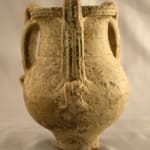Hellenistic Glazed Terracotta Vessel with Three Handles, 300 BCE - 100 BCE
Glazed Terracotta
4 x 5.5
CK.0153
Further images
The conquests of Alexander the Great had a dramatic influence not only on the political structure of the Classical world, but also on the artistic landscape. The strict rules and...
The conquests of Alexander the Great had a dramatic influence not only on the political structure of the Classical world, but also on the artistic landscape. The strict rules and conventions that guided the aesthetic of the Classical era were expanded upon to allow artists to experiment with new forms and approaches. While the gods and mythology remained the dominant subjects, themes of everyday life became increasingly popular. Overall, the Hellenistic era can be characterized by a sense of increased naturalism as opposed to the idealized forms typical of the Classical age. In effect, Hellenistic naturalism can be viewed as a reaction to the works of the 4th Century master sculptors such as Praxitelis and Lysipos who sought to depict the human figure in more realistic terms. Sculptors and painters manipulated the effects of light and shadow to create dramatic compositions full of energy and emotion that depicted their subjects in moments of extreme tension or reflective meditation. The Hellenistic age remains one of the most important period in the history of Western Art, whose impact could be felt almost two thousand years later during the Baroque style of 17th Century Europe.
This vessel has been covered in an ochre-colored glaze. Three handles rise from the body and join along the upper rim. While such a vessel is perhaps more utilitarian that the highly decorated pottery traditionally associated with Ancient Greece, it still demonstrates a pleasing ornamentation beyond the purely functional.
This vessel has been covered in an ochre-colored glaze. Three handles rise from the body and join along the upper rim. While such a vessel is perhaps more utilitarian that the highly decorated pottery traditionally associated with Ancient Greece, it still demonstrates a pleasing ornamentation beyond the purely functional.





